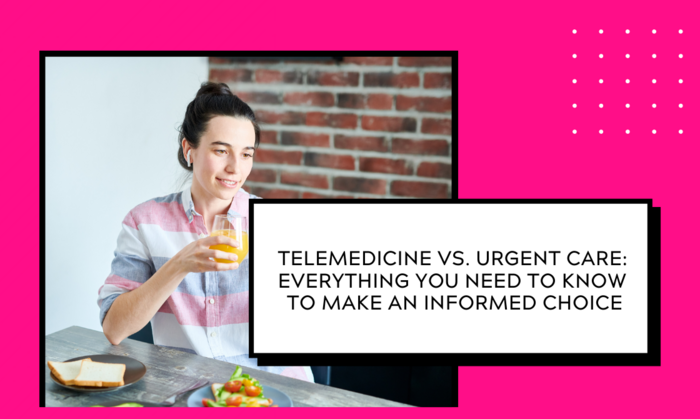
Feel better faster. Get care today.
From the clinic or your couch. Find high quality, same-day urgent care for you and your kids. Book an urgent care visit today.

You know as well as we do that going to the doctor is time-consuming. More likely than not, you’ll wait weeks to get an appointment with your primary care doctor or a specialist. When it’s time for your appointment, you’ll spend an average of 121 minutes on a trip to the doctor—that’s enough time to, well, do a whole lot of things you’d rather do than see your doctor. Whether that time is spent in the car getting to your appointment or sitting in a waiting room, it’s frustrating, to say the least. And if you live in a rural area, you’re probably going to spend even more time due to the shortage of doctors that most non-urban regions are faced with.
That’s where urgent care and telemedicine come in. Though they each have a time and place where it’s appropriate to use them (like don’t try to get a telemedicine visit for a broken arm... please go to urgent care), they are both designed to make healthcare more accessible. Not only is an urgent care physician able to see you faster than a traditional doctor, but you’ll also likely be able to get care at a fraction of the cost.
Urgent care appointments and telemedicine appointments can both be booked same-day or next-day, saving you time and getting you better, faster but the main difference is that with telemedicine, you don’t even have to leave your house (or office). This is great for saving all that time you’d typically spend driving, waiting, and wishing you were home in your yoga pants.
Like many healthcare options, knowing when to choose urgent care and when to book a telemedicine appointment can be confusing. When you or your child isn’t feeling well, you don’t want to be faced with a decision between in-person treatment at urgent care and having a doctor’s visit via video chat, so it’s a good idea to learn which is best for different health concerns before you need care. Below, we dig deeper into how to choose and give you some insider knowledge on just how critical both urgent care and telemedicine are for patients.
First, a short history lesson. Urgent care centers started popping up in the 1970s when physicians saw an unmet need for same-day non-emergency care. These new clinics gave people access to high-quality care with shorter wait times and lower out-of-pocket costs. Before urgent care was a thing, you could only find that at doctors’ offices and hospitals, and the wait times were much longer.
Today, convenient care clinics see about 160 million patient visits each year, nearly all of which are more affordable and convenient than a trip to the ER.
A recent survey found that almost half of millennials don’t have a primary care physician (PCP), mostly because they can’t find one that offers the convenience and customer service that they expect from their doctors. Instead, they turn to urgent care centers when they need same-day face-to-face care. According to the same survey, a growing number of Baby Boomers are even catching on to how convenient and affordable urgent care is, too.
Since their creation, these clinics have evolved to offer more than a convenient treatment for common illnesses, such as the cold and flu. Many urgent care centers can also provide more complex services, including x-rays for broken bones, blood work, stitching up small wounds, and giving intravenous (IV) medications and fluids. Some even take accessible same-day care one step further by offering telemedicine services, in addition to in-person appointments.
Sometimes you just don’t want to leave the house. Or deal with traffic. Or people. We feel that. Telemedicine is the solution to all of these woes. By using the same kind of technology you’re already familiar with, like video chat, texting, and email, telemedicine gives you access to the healthcare you need, from wherever you are. Of course, you do need access to a smartphone or a computer with a camera, as well as an internet connection or cell reception. It’s important to acknowledge that not all people, especially those in remote or lower-income areas, have readily available access to these. This is an issue that many healthcare professionals are working hard to fix.
When telemedicine services first became available, doctors and patients alike wondered whether virtual visits could give the same quality of care as face-to-face care. Over the past couple of decades, studies have found that telemedicine has more than proven its worth. Not only do studies show that patients have the same, or better, health outcomes as those receiving face-to-face care, but also the usage of telemedicine has skyrocketed. Today, as many as 7 million people rely on telemedicine for healthcare that doesn’t require in-person attention, making virtual visits the fastest-growing way to get medical care.
Telemedicine visits can be booked online through Solv, as well as participating doctors’ offices and urgent care centers. Many providers offer same-day or next-day visits, twenty-four hours a day, seven days a week. Many common health conditions, from sore throats to rashes to joint aches and pains, can be treated through these virtual visits. Doctors may also use telemedicine to refill prescriptions, discuss lab results, and help patients manage chronic diseases.
During a typical telemedicine visit, you’ll video chat with a provider and discuss your current health concerns. They’ll use all that medical knowledge they’ve acquired from years of schooling and treating patients and apply it to your situation, assessing your symptoms the same way they would if you were sitting on one of those awkward doctor’s tables. You’ll get a diagnosis, recommended treatment, and, if needed, a prescription. Just like you would in-person. Are you noticing the trend? Telemedicine care is healthcare like you’d expect it to be, you just don’t have to leave your couch to use it.
It’s not just primary care visits that can be replaced with virtual care. Many specialists have also embraced telemedicine. Appointments with dermatologists, allergists, psychiatrists, oncologists, and even obstetricians can now be booked completely online. This is a win for patients who used to have to wait weeks (or, in some cases, months) for a face-to-face appointment with a specialist.
We surveyed 2,000 Americans and found that 31% of people that went to the emergency room only went because they thought it was the most convenient option. If only they had known urgent care was a more convenient option, 65% of people would have chosen that instead (and saved a lot of money).
While ER visits can leave you with a medical bill of $500 or more, urgent care visits typically only cost between $100 and $200. If you have health insurance, you’ll only have to pay the amount of your copay (the fee you pay for care after you’ve met your deductible and insurance has started helping out), which is typically between $35 and $75 for a trip to urgent care.
Pro Tip: If you’re uninsured, going to the emergency room isn’t your only option. Many urgent care centers post their prices online so that people without insurance know exactly how much they can expect to pay before they visit the doctor. Some even offer cash-pay discounts or payment plans for people that are paying for their care out of pocket.
When it comes to health concerns that are urgent, but not necessarily an emergency, patients can save hundreds of dollars by choosing telemedicine or urgent care over the hospital.
During a virtual visit, a doctor can help with many of the same things that you’d normally have to wait days, weeks, or months, to discuss with your primary care doctor.
So, when should you book a telemedicine appointment? You might book a telemedicine visit when you have one of the following health concerns:
While telemedicine is great for general care appointments, you can also use them to see a wide range of medical specialists.
Specialists that offer telemedicine services include:
Not everything can be treated during a video visit with your physician. When you need in-person medical care, an urgent care center may be your best choice. Urgent care centers employ family practice and emergency physicians, registered nurses, and radiology technicians, and they offer many of the same services as the emergency room—with shorter wait times and lower prices.
Most urgent care clinics can provide you with:
Going to the doctor will never be fun, but it also doesn’t need to be time consuming or expensive. At Solv, we believe that the patient (you!) should be in control of your healthcare. Telemedicine and urgent care are both options that, when used for the right care, at the right time, can make healthcare less frustrating. When you need care now, book through Solv. We’ve got your back.
Urgent care provides faster access to medical care and is generally less expensive than traditional doctor visits.
Telemedicine can address a range of health concerns including allergy and asthma flare-ups, respiratory or sinus infections, joint aches and pain, and reviewing lab or test results.
Yes, telemedicine requires access to a smartphone or a computer with a camera, as well as an internet connection or cell reception, which may not be readily available to everyone.
A wide range of medical specialists offer telemedicine services, including allergists, cardiologists, dermatologists, oncologists, obstetricians, gynecologists, and psychiatrists.
Urgent care should be chosen over telemedicine when you need in-person medical care, such as x-rays, IV fluids and medications, care for deep cuts, setting minor fractures, and blood work.
Urgent care visits typically cost between $100 and $200. If you have health insurance, you’ll only have to pay the amount of your copay, which is typically between $35 and $75 for a trip to urgent care.
You might choose telemedicine when you have health concerns like allergy and asthma flare-ups, cough, cold, flu, headache, joint aches and pain, nausea and vomiting, rash, infection, insect bite, or small wound. You can also use telemedicine for reviewing lab or test results and following up on a previous visit.
You should choose urgent care when you need in-person medical care. Most urgent care clinics can provide you with x-rays and other diagnostic imaging tests, IV fluids and medications, care for deep cuts and abscesses, setting minor fractures, strep throat, flu, and mononucleosis tests, sexually-transmitted infection (STI) tests, flu shots and other vaccines, physical exams for school, work, or athletics, drug testing, and blood work.

From the clinic or your couch. Find high quality, same-day urgent care for you and your kids. Book an urgent care visit today.